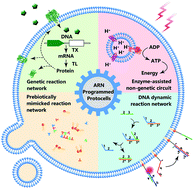当前位置:
X-MOL 学术
›
Chem. Sci.
›
论文详情
Our official English website, www.x-mol.net, welcomes your
feedback! (Note: you will need to create a separate account there.)
Protocells programmed through artificial reaction networks
Chemical Science ( IF 7.6 ) Pub Date : 2019-12-19 , DOI: 10.1039/c9sc05043d Yifan Lyu 1, 2, 3, 4, 5 , Ruizi Peng 4, 6, 7, 8, 9 , Hui Liu 4, 6, 7, 8, 9 , Hailan Kuai 4, 6, 7, 8, 9 , Liuting Mo 4, 6, 7, 8, 9 , Da Han 1, 2, 3, 4, 5 , Juan Li 1, 2, 3, 4, 5 , Weihong Tan 1, 2, 3, 4, 5
Chemical Science ( IF 7.6 ) Pub Date : 2019-12-19 , DOI: 10.1039/c9sc05043d Yifan Lyu 1, 2, 3, 4, 5 , Ruizi Peng 4, 6, 7, 8, 9 , Hui Liu 4, 6, 7, 8, 9 , Hailan Kuai 4, 6, 7, 8, 9 , Liuting Mo 4, 6, 7, 8, 9 , Da Han 1, 2, 3, 4, 5 , Juan Li 1, 2, 3, 4, 5 , Weihong Tan 1, 2, 3, 4, 5
Affiliation

|
As the smallest unit of life, cells attract interest due to their structural complexity and functional reliability. Protocells assembled by inanimate components are created as an artificial entity to mimic the structure and some essential properties of a natural cell, and artificial reaction networks are used to program the functions of protocells. Although the bottom-up construction of a protocell that can be considered truly ‘alive’ is still an ambitious goal, these man-made constructs with a certain degree of ‘liveness’ can offer effective tools to understand fundamental processes of cellular life, and have paved the new way for bionic applications. In this review, we highlight both the milestones and recent progress of protocells programmed by artificial reaction networks, including genetic circuits, enzyme-assisted non-genetic circuits, prebiotic mimicking reaction networks, and DNA dynamic circuits. Challenges and opportunities have also been discussed.
中文翻译:

通过人工反应网络对原始细胞进行编程
作为生命的最小单位,细胞因其结构复杂性和功能可靠性而受到关注。由无生命成分组装的原始细胞被创建为模拟天然细胞的结构和某些基本特性的人工实体,并且人工反应网络被用来对原始细胞的功能进行编程。尽管自下而上构建真正可以被认为是“活着”的原始细胞仍然是一个雄心勃勃的目标,但是这些具有一定“活力”的人造构建物可以提供有效的工具来理解细胞生命的基本过程,并具有为仿生应用铺平了道路。在这篇综述中,我们重点介绍了由人工反应网络(包括遗传电路,酶辅助非遗传电路,益生元模仿反应网络和DNA动态电路。还讨论了挑战和机遇。
更新日期:2020-01-07
中文翻译:

通过人工反应网络对原始细胞进行编程
作为生命的最小单位,细胞因其结构复杂性和功能可靠性而受到关注。由无生命成分组装的原始细胞被创建为模拟天然细胞的结构和某些基本特性的人工实体,并且人工反应网络被用来对原始细胞的功能进行编程。尽管自下而上构建真正可以被认为是“活着”的原始细胞仍然是一个雄心勃勃的目标,但是这些具有一定“活力”的人造构建物可以提供有效的工具来理解细胞生命的基本过程,并具有为仿生应用铺平了道路。在这篇综述中,我们重点介绍了由人工反应网络(包括遗传电路,酶辅助非遗传电路,益生元模仿反应网络和DNA动态电路。还讨论了挑战和机遇。











































 京公网安备 11010802027423号
京公网安备 11010802027423号